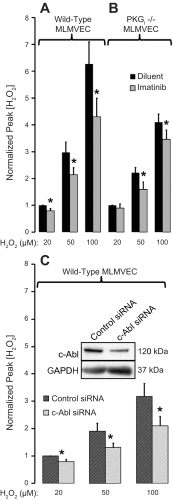Protein kinase G increases antioxidant function in lung microvascular endothelial cells by inhibiting the c-Abl tyrosine kinase
- PMID: 24401847
- PMCID: PMC3948974
- DOI: 10.1152/ajpcell.00375.2012
Protein kinase G increases antioxidant function in lung microvascular endothelial cells by inhibiting the c-Abl tyrosine kinase
Abstract
Oxidant injury contributes to acute lung injury (ALI). We previously reported that activation of protein kinase GI (PKGI) posttranscriptionally increased the key antioxidant enzymes catalase and glutathione peroxidase 1 (Gpx-1) and attenuated oxidant-induced cytotoxicity in mouse lung microvascular endothelial cells (MLMVEC). The present studies tested the hypothesis that the antioxidant effect of PKGI is mediated via inhibition of the c-Abl tyrosine kinase. We found that activation of PKGI with the cGMP analog 8pCPT-cGMP inhibited c-Abl activity and decreased c-Abl expression in wild-type but not PKGI(-/-) MLMVEC. Treatment of wild-type MLMVEC with atrial natriuretic peptide also inhibited c-Abl activation. Moreover, treatment of MLMVEC with the c-Abl inhibitor imatinib increased catalase and GPx-1 protein in a posttranscriptional fashion. In imatinib-treated MLMVEC, there was no additional effect of 8pCPT-cGMP on catalase or GPx-1. The imatinib-induced increase in antioxidant proteins was associated with an increase in extracellular H2O2 scavenging by MLMVEC, attenuation of oxidant-induced endothelial barrier dysfunction, and prevention of oxidant-induced endothelial cell death. Finally, in the isolated perfused lung, imatinib prevented oxidant-induced endothelial toxicity. We conclude that cGMP, through activation of PKGI, inhibits c-Abl, leading to increased key antioxidant enzymes and resistance to lung endothelial oxidant injury. Inhibition of c-Abl by active PKGI may be the downstream mechanism underlying PKGI-mediated antioxidant signaling. Tyrosine kinase inhibitors may represent a novel therapeutic approach in oxidant-induced ALI.
Keywords: acute lung injury; c-Abl; endothelium; oxidant injury; protein kinase G.
Figures








Similar articles
-
Targeting Abl kinases to regulate vascular leak during sepsis and acute respiratory distress syndrome.Arterioscler Thromb Vasc Biol. 2015 May;35(5):1071-9. doi: 10.1161/ATVBAHA.115.305085. Epub 2015 Mar 26. Arterioscler Thromb Vasc Biol. 2015. PMID: 25814671 Free PMC article. Review.
-
Differential and opposing effects of imatinib on LPS- and ventilator-induced lung injury.Am J Physiol Lung Cell Mol Physiol. 2015 Feb 1;308(3):L259-69. doi: 10.1152/ajplung.00323.2014. Epub 2014 Dec 5. Am J Physiol Lung Cell Mol Physiol. 2015. PMID: 25480336 Free PMC article.
-
cGMP increases antioxidant function and attenuates oxidant cell death in mouse lung microvascular endothelial cells by a protein kinase G-dependent mechanism.Am J Physiol Lung Cell Mol Physiol. 2010 Sep;299(3):L323-33. doi: 10.1152/ajplung.00442.2009. Epub 2010 May 7. Am J Physiol Lung Cell Mol Physiol. 2010. PMID: 20453163 Free PMC article.
-
Abl family kinases regulate endothelial barrier function in vitro and in mice.PLoS One. 2013 Dec 19;8(12):e85231. doi: 10.1371/journal.pone.0085231. eCollection 2013. PLoS One. 2013. PMID: 24367707 Free PMC article.
-
Combination of the ABL kinase inhibitor imatinib with the Janus kinase 2 inhibitor TG101348 for targeting residual BCR-ABL-positive cells.J Hematol Oncol. 2014 Apr 28;7:37. doi: 10.1186/1756-8722-7-37. J Hematol Oncol. 2014. PMID: 24775308 Free PMC article.
Cited by
-
Intravenous Injection of Na Ions Aggravates Ang II-Induced Hypertension-Related Vascular Endothelial Injury by Increasing Transmembrane Osmotic Pressure.Int J Nanomedicine. 2023 Dec 11;18:7505-7521. doi: 10.2147/IJN.S435144. eCollection 2023. Int J Nanomedicine. 2023. PMID: 38106448 Free PMC article.
-
Targeting Abl kinases to regulate vascular leak during sepsis and acute respiratory distress syndrome.Arterioscler Thromb Vasc Biol. 2015 May;35(5):1071-9. doi: 10.1161/ATVBAHA.115.305085. Epub 2015 Mar 26. Arterioscler Thromb Vasc Biol. 2015. PMID: 25814671 Free PMC article. Review.
-
The Dual Role of Microglia in Blood-Brain Barrier Dysfunction after Stroke.Curr Neuropharmacol. 2020;18(12):1237-1249. doi: 10.2174/1570159X18666200529150907. Curr Neuropharmacol. 2020. PMID: 32469699 Free PMC article. Review.
-
Differential and opposing effects of imatinib on LPS- and ventilator-induced lung injury.Am J Physiol Lung Cell Mol Physiol. 2015 Feb 1;308(3):L259-69. doi: 10.1152/ajplung.00323.2014. Epub 2014 Dec 5. Am J Physiol Lung Cell Mol Physiol. 2015. PMID: 25480336 Free PMC article.
-
Imatinib attenuates inflammation and vascular leak in a clinically relevant two-hit model of acute lung injury.Am J Physiol Lung Cell Mol Physiol. 2015 Dec 1;309(11):L1294-304. doi: 10.1152/ajplung.00031.2015. Epub 2015 Oct 2. Am J Physiol Lung Cell Mol Physiol. 2015. PMID: 26432864 Free PMC article.
References
-
- Agami R, Blandino G, Oren M, Shaul Y. Interaction of c-Abl and p73alpha and their collaboration to induce apoptosis. Nature 399: 809–813, 1999 - PubMed
-
- Akashi N, Matsumoto I, Tanaka Y, Inoue A, Yamamoto K, Umeda N, Tanaka Y, Hayashi T, Goto D, Ito S, Sekiguchi K, Sumida T. Comparative suppressive effects of tyrosine kinase inhibitors imatinib and nilotinib in models of autoimmune arthritis. Mod Rheumatol 21: 267–275, 2011 - PubMed
-
- Aman J, van BJ, Damanafshan A, Huveneers S, Eringa EC, Vogel SM, Groeneveld AB, Vonk NA, van Hinsbergh VW, van Nieuw Amerongen GP. Effective treatment of edema and endothelial barrier dysfunction with imatinib. Circulation 126: 2728–2738, 2012 - PubMed
-
- Awazu M. Inhibition of platelet-derived growth factor receptor tyrosine kinase by atrial natriuretic peptide. Kidney Int 52: 356–362, 1997 - PubMed
-
- Brasher BB, Van Etten RA. c-Abl has high intrinsic tyrosine kinase activity that is stimulated by mutation of the Src homology 3 domain and by autophosphorylation at two distinct regulatory tyrosines. J Biol Chem 275: 35631–35637, 2000 - PubMed
Publication types
MeSH terms
Substances
Grants and funding
LinkOut - more resources
Full Text Sources
Other Literature Sources
Molecular Biology Databases
Miscellaneous

